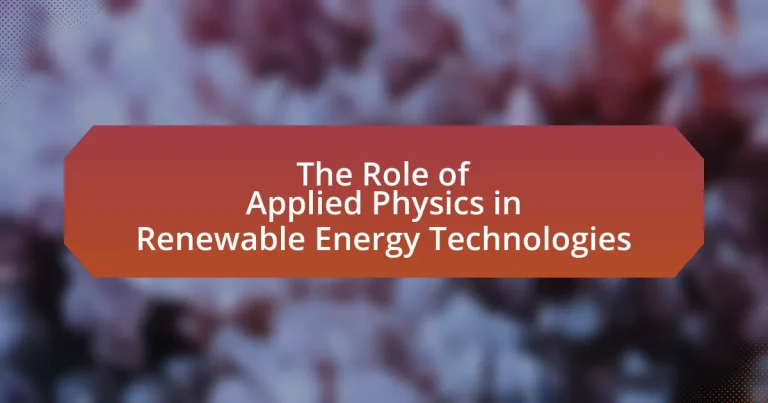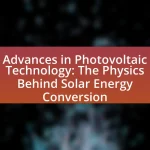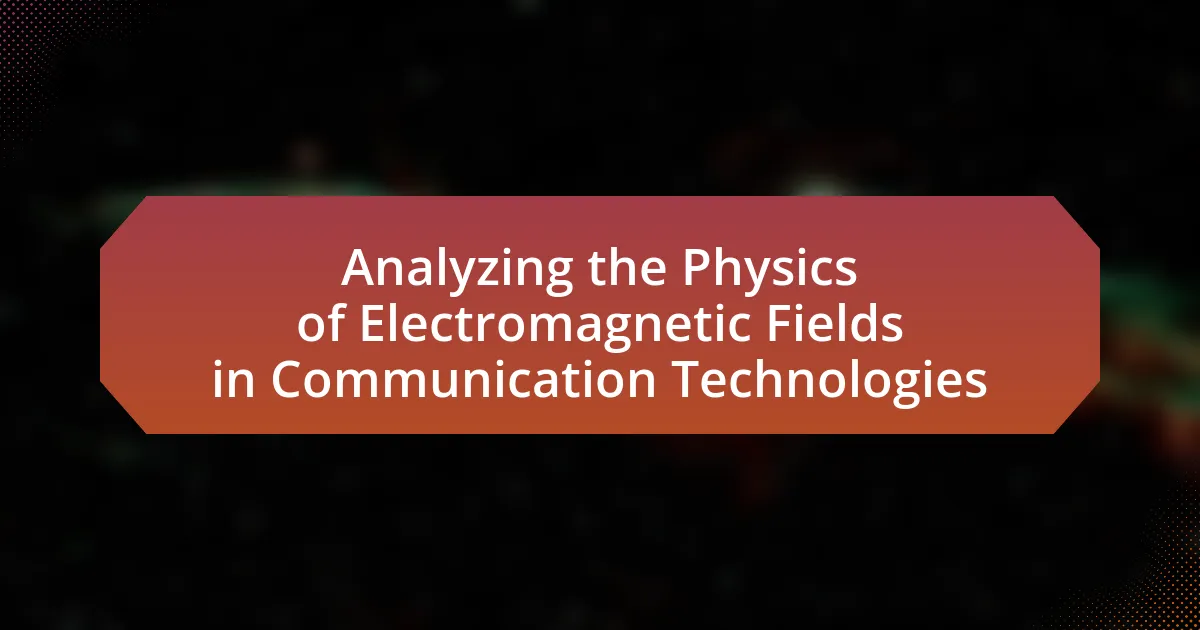The article focuses on the critical role of applied physics in the advancement of renewable energy technologies. It highlights how applied physics principles, such as thermodynamics, electromagnetism, and fluid dynamics, are essential for optimizing systems like solar panels, wind turbines, and energy storage solutions. Key contributions include the development of high-efficiency photovoltaic cells, improved wind turbine designs, and innovative energy storage systems, all driven by advancements in materials science and engineering. The article also addresses the challenges faced in integrating renewable energy sources into existing systems and emphasizes the importance of interdisciplinary collaboration and research in overcoming these obstacles.
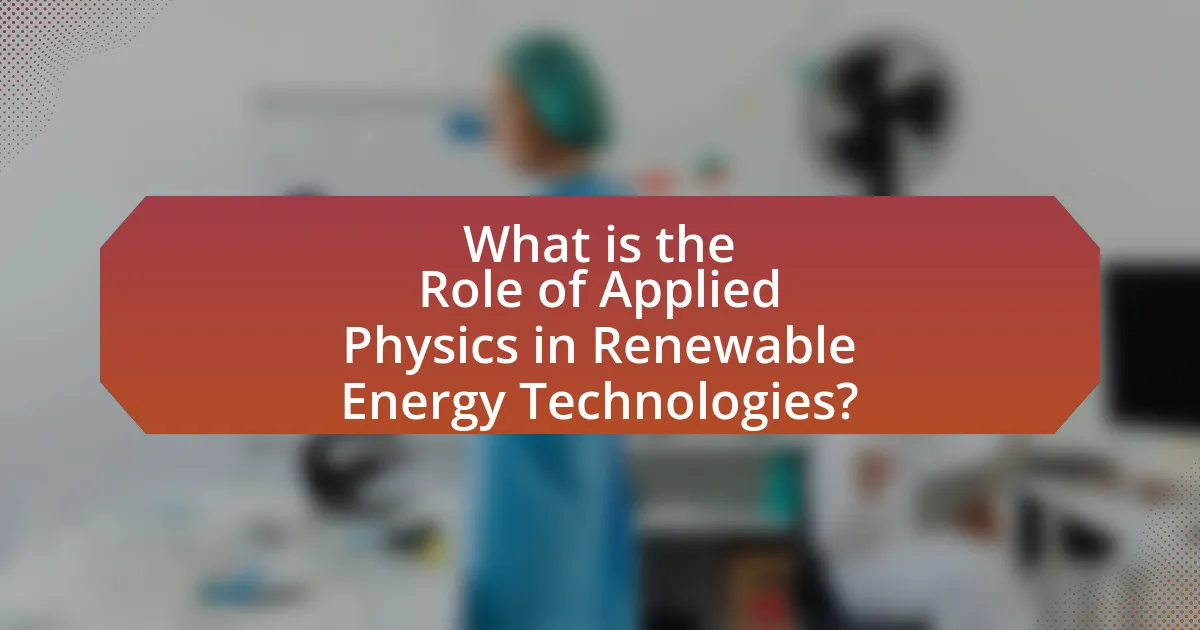
What is the Role of Applied Physics in Renewable Energy Technologies?
Applied physics plays a crucial role in the development and optimization of renewable energy technologies by applying fundamental physical principles to solve practical energy challenges. This discipline aids in the design and enhancement of systems such as solar panels, wind turbines, and energy storage solutions, ensuring they operate efficiently and effectively. For instance, the principles of thermodynamics and electromagnetism are essential in improving the efficiency of photovoltaic cells, which convert sunlight into electricity. Research indicates that advancements in applied physics have led to significant increases in solar cell efficiency, with some technologies achieving over 25% efficiency rates. Additionally, applied physics contributes to the understanding of materials science, which is vital for developing new materials that can withstand environmental stresses while maximizing energy output.
How does applied physics contribute to the development of renewable energy technologies?
Applied physics significantly contributes to the development of renewable energy technologies by providing the fundamental principles and methodologies necessary for innovation and optimization. For instance, applied physics enables the design and improvement of solar cells through the understanding of semiconductor physics, which has led to the development of more efficient photovoltaic materials, such as perovskite solar cells, achieving efficiencies over 25% in laboratory settings. Additionally, applied physics plays a crucial role in wind energy by informing the aerodynamics of turbine blade design, resulting in increased energy capture and efficiency. Research indicates that advancements in applied physics have led to a 50% increase in wind turbine efficiency over the past two decades. Thus, the integration of applied physics into renewable energy technologies is essential for enhancing performance, reducing costs, and accelerating the transition to sustainable energy sources.
What fundamental principles of physics are applied in renewable energy systems?
Renewable energy systems apply fundamental principles of physics such as thermodynamics, electromagnetism, and fluid dynamics. Thermodynamics governs energy conversion processes, such as in solar panels where sunlight is converted into electricity through the photovoltaic effect, which is rooted in the principles of energy conservation and entropy. Electromagnetism is crucial in wind turbines and hydroelectric systems, where kinetic energy from wind or flowing water is transformed into electrical energy via electromagnetic induction, as described by Faraday’s law. Fluid dynamics plays a significant role in the design and efficiency of these systems, influencing how fluids interact with turbine blades and other components to optimize energy capture. These principles collectively ensure the effective harnessing and conversion of renewable energy sources into usable power.
How do these principles enhance energy efficiency and sustainability?
The principles of applied physics enhance energy efficiency and sustainability by optimizing energy conversion processes and minimizing waste. For instance, advancements in thermodynamics and fluid dynamics allow for the design of more efficient solar panels and wind turbines, which can convert a higher percentage of available energy into usable power. Research indicates that modern photovoltaic cells can achieve efficiencies exceeding 22%, significantly improving energy output compared to earlier technologies. Additionally, principles of materials science contribute to the development of lightweight, durable materials that reduce the energy required for manufacturing and transportation, further promoting sustainability.
Why is applied physics essential for innovation in renewable energy?
Applied physics is essential for innovation in renewable energy because it provides the foundational principles that drive the development and optimization of energy technologies. By applying concepts from physics, researchers can enhance the efficiency of solar panels, improve wind turbine designs, and develop advanced energy storage systems. For instance, the efficiency of photovoltaic cells has increased significantly due to advancements in materials science, which is rooted in applied physics. Studies show that the efficiency of solar cells has improved from about 15% to over 25% in recent years, largely due to innovations in semiconductor physics. Thus, applied physics is crucial for creating more effective and sustainable renewable energy solutions.
What breakthroughs in renewable energy have been driven by applied physics?
Breakthroughs in renewable energy driven by applied physics include the development of highly efficient solar cells, advancements in wind turbine technology, and innovations in energy storage systems. For instance, the introduction of perovskite solar cells, which utilize materials with a specific crystal structure, has led to efficiencies exceeding 25%, significantly improving solar energy conversion rates. Additionally, applied physics has enabled the design of larger and more efficient wind turbines, which can capture more energy from wind due to advancements in aerodynamics and materials science. Furthermore, breakthroughs in battery technology, such as lithium-sulfur batteries, have been made possible through applied physics, allowing for higher energy densities and longer lifespans, thus enhancing the viability of renewable energy sources. These advancements demonstrate the critical role of applied physics in transforming renewable energy technologies.
How does applied physics facilitate the integration of renewable energy sources into existing systems?
Applied physics facilitates the integration of renewable energy sources into existing systems by providing the scientific principles and technological frameworks necessary for efficient energy conversion, storage, and distribution. For instance, applied physics enables the development of advanced materials for solar panels, which enhance light absorption and conversion efficiency, leading to higher energy output. Additionally, it informs the design of smart grids that optimize energy flow and manage the variability of renewable sources like wind and solar. Research indicates that the implementation of these technologies can increase grid reliability and reduce energy losses, as demonstrated by the integration of smart grid technologies in countries like Germany, which has significantly increased renewable energy usage while maintaining grid stability.
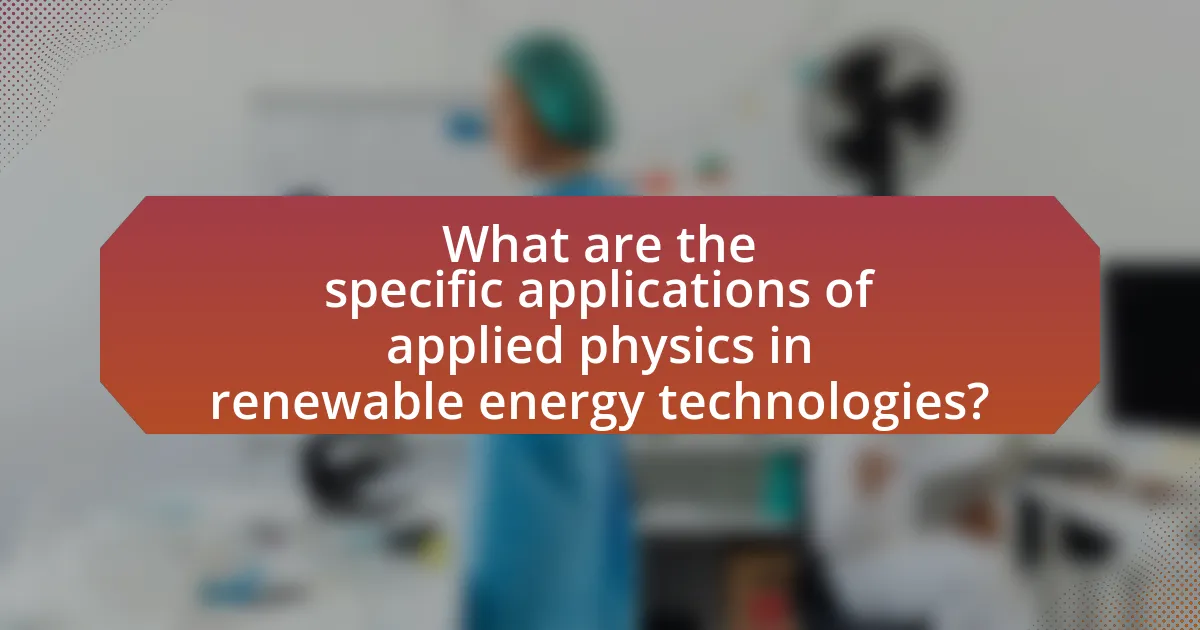
What are the specific applications of applied physics in renewable energy technologies?
Applied physics plays a crucial role in renewable energy technologies through applications such as solar energy conversion, wind energy optimization, and energy storage systems. In solar energy, applied physics is utilized to enhance photovoltaic cell efficiency by studying the properties of materials and light interaction, leading to advancements in solar panel technology. For wind energy, applied physics contributes to the design and optimization of wind turbines by analyzing aerodynamics and mechanical properties, which improves energy capture and reduces costs. Additionally, in energy storage, applied physics informs the development of batteries and supercapacitors by exploring electrochemical processes and material science, resulting in more efficient energy storage solutions. These applications demonstrate how applied physics directly influences the effectiveness and advancement of renewable energy technologies.
How is applied physics utilized in solar energy technologies?
Applied physics is utilized in solar energy technologies primarily through the development and optimization of photovoltaic cells, which convert sunlight into electricity. This application involves principles of quantum mechanics and materials science to enhance the efficiency of solar panels. For instance, the use of semiconductor materials, such as silicon, is grounded in applied physics, allowing for the effective absorption of photons and the generation of charge carriers. Research indicates that advancements in nanotechnology and thin-film solar cells, which leverage applied physics concepts, have led to efficiencies exceeding 25% in laboratory settings, demonstrating the critical role of applied physics in improving solar energy technologies.
What role do photovoltaic cells play in solar energy conversion?
Photovoltaic cells convert sunlight directly into electricity through the photovoltaic effect. This process involves the absorption of photons by semiconductor materials, typically silicon, which generates electron-hole pairs. When these charge carriers are separated by an internal electric field within the cell, they create a flow of electric current. According to the U.S. Department of Energy, photovoltaic technology has seen a significant increase in efficiency, with modern cells achieving conversion efficiencies of over 20%. This efficiency is crucial for maximizing energy output from solar installations, thereby enhancing the viability of solar energy as a renewable resource.
How does thermodynamics influence solar thermal energy systems?
Thermodynamics significantly influences solar thermal energy systems by governing the conversion of solar energy into usable thermal energy. The principles of thermodynamics, particularly the laws of energy conservation and entropy, dictate how efficiently solar collectors can absorb sunlight and convert it into heat. For instance, the first law of thermodynamics ensures that the energy absorbed by the solar collector is equal to the energy output, minus losses due to inefficiencies. Additionally, the second law of thermodynamics highlights the importance of temperature differentials in maximizing heat transfer, which is crucial for the efficiency of solar thermal systems. Studies have shown that optimizing these thermodynamic principles can enhance the performance of solar thermal systems, leading to higher energy yields and improved overall efficiency.
What contributions does applied physics make to wind energy technologies?
Applied physics significantly contributes to wind energy technologies by enhancing the design, efficiency, and performance of wind turbines. Through the application of fluid dynamics, applied physics helps optimize turbine blade shapes to maximize energy capture from wind, leading to increased efficiency. For instance, computational fluid dynamics (CFD) simulations allow engineers to analyze airflow patterns around turbine blades, resulting in designs that can improve energy output by up to 20%. Additionally, applied physics principles are crucial in developing materials that withstand harsh environmental conditions, ensuring the durability and longevity of wind turbines. Research indicates that advancements in material science, such as the use of lightweight composites, can reduce turbine weight and improve performance, further contributing to the effectiveness of wind energy technologies.
How do aerodynamic principles affect wind turbine design and efficiency?
Aerodynamic principles significantly influence wind turbine design and efficiency by determining how effectively turbines convert wind energy into mechanical energy. The shape and orientation of turbine blades, designed based on aerodynamic theories, optimize lift and minimize drag, which enhances energy capture. For instance, the use of airfoil-shaped blades allows for a more efficient flow of air, resulting in increased lift-to-drag ratios. Studies show that optimizing blade pitch and rotor diameter can improve energy output by up to 20%. Additionally, the angle of attack, which is the angle between the blade and the oncoming wind, is crucial for maximizing performance. Properly applying these aerodynamic principles leads to higher efficiency and better overall performance of wind turbines.
What physical factors determine the optimal placement of wind farms?
The optimal placement of wind farms is determined by several physical factors, including wind speed, terrain, proximity to power infrastructure, and environmental impact. Wind speed is critical, as higher average speeds lead to greater energy production; for instance, areas with wind speeds of 6-9 meters per second are often ideal. Terrain affects wind flow; flat, open areas typically allow for better wind access compared to hilly or forested regions. Proximity to existing power lines and substations reduces transmission costs and losses, making locations near these infrastructures more favorable. Additionally, environmental considerations, such as wildlife habitats and land use, must be evaluated to minimize ecological disruption. These factors collectively ensure that wind farms operate efficiently and sustainably.
How does applied physics enhance energy storage solutions in renewable energy?
Applied physics enhances energy storage solutions in renewable energy by optimizing materials and systems for efficiency and performance. For instance, advancements in battery technology, such as lithium-ion and solid-state batteries, are driven by principles of applied physics that improve energy density and charge cycles. Research indicates that solid-state batteries can potentially offer energy densities exceeding 300 Wh/kg, significantly higher than traditional lithium-ion batteries, which typically range from 150 to 250 Wh/kg. Additionally, applied physics contributes to the development of supercapacitors and flywheel energy storage systems, which provide rapid charge and discharge capabilities, essential for balancing intermittent renewable sources like solar and wind. These innovations are crucial for enhancing the reliability and scalability of renewable energy systems.
What are the key physical principles behind battery technology for renewable energy?
The key physical principles behind battery technology for renewable energy include electrochemistry, thermodynamics, and charge transport. Electrochemistry governs the chemical reactions that occur within the battery, allowing for the conversion of chemical energy into electrical energy. For instance, lithium-ion batteries operate through the movement of lithium ions between the anode and cathode during charging and discharging cycles, which is a direct application of electrochemical principles.
Thermodynamics plays a crucial role in determining the efficiency and energy density of batteries, as it dictates how energy is stored and released based on temperature and pressure conditions. Additionally, charge transport, which involves the movement of electrons and ions within the battery materials, affects the overall performance and longevity of the battery. For example, the conductivity of electrode materials directly influences how quickly a battery can charge and discharge, impacting its usability in renewable energy applications.
These principles are foundational in the design and optimization of batteries, ensuring they meet the demands of renewable energy systems effectively.
How do advancements in applied physics improve the efficiency of energy storage systems?
Advancements in applied physics enhance the efficiency of energy storage systems by optimizing materials and processes used in batteries and capacitors. For instance, research into nanomaterials has led to the development of electrodes with higher surface areas, which significantly increases charge capacity and reduces charging times. A study published in the journal “Nature Nanotechnology” by authors including Wang et al. demonstrated that using graphene-based materials in lithium-ion batteries can improve energy density by up to 30%. Additionally, advancements in thermodynamics and electrochemistry allow for better thermal management and energy conversion processes, further increasing overall system efficiency.
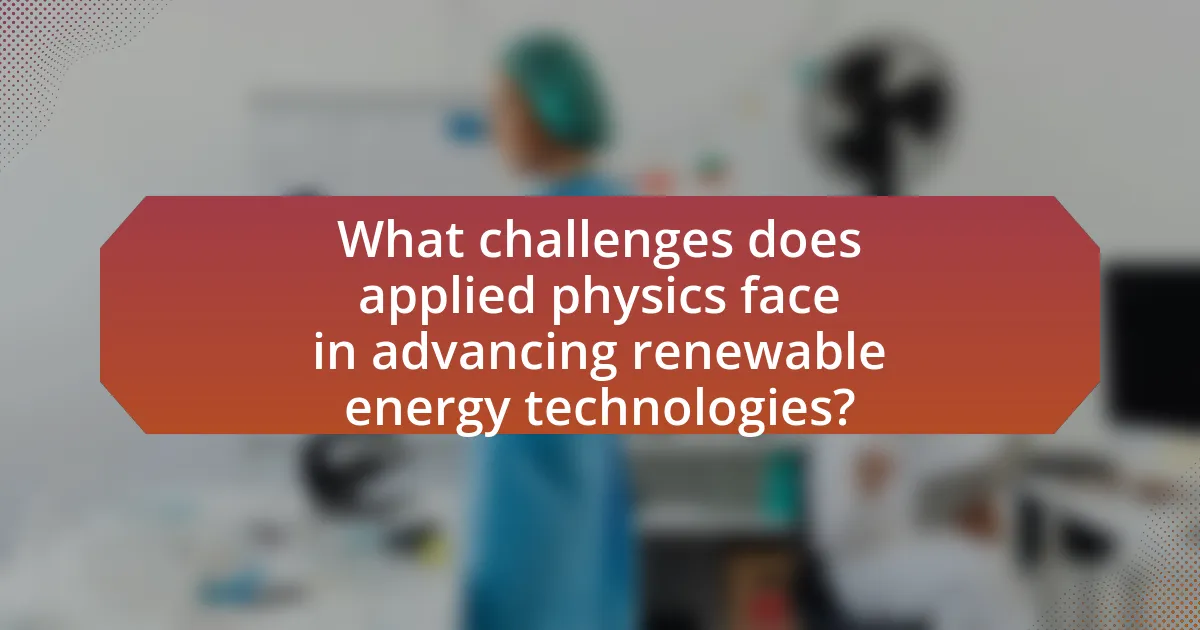
What challenges does applied physics face in advancing renewable energy technologies?
Applied physics faces several challenges in advancing renewable energy technologies, primarily related to material limitations, efficiency optimization, and integration with existing systems. For instance, the development of high-efficiency solar cells is hindered by the availability of suitable materials that can effectively convert sunlight into electricity while maintaining cost-effectiveness. Research indicates that while perovskite solar cells show promise, issues such as stability and scalability remain significant hurdles. Additionally, optimizing energy conversion processes, such as those in wind turbines and bioenergy systems, requires advanced modeling and simulation techniques to enhance performance under varying environmental conditions. Furthermore, integrating renewable energy sources into existing power grids poses challenges in terms of energy storage and distribution, necessitating innovative solutions in applied physics to ensure reliability and efficiency.
What are the limitations of current applied physics applications in renewable energy?
Current applied physics applications in renewable energy face several limitations, including efficiency constraints, material availability, and integration challenges. For instance, solar panels typically convert only about 15-22% of sunlight into electricity, which limits their overall effectiveness. Additionally, many renewable technologies rely on rare materials, such as indium and tellurium for thin-film solar cells, which can hinder large-scale production. Furthermore, integrating renewable energy sources into existing power grids poses significant challenges due to variability in energy generation and the need for advanced storage solutions. These limitations highlight the need for ongoing research and development in applied physics to enhance the performance and scalability of renewable energy technologies.
How do material constraints impact the efficiency of renewable energy technologies?
Material constraints significantly impact the efficiency of renewable energy technologies by limiting the performance and scalability of materials used in these systems. For instance, in solar panels, the efficiency of photovoltaic cells is often restricted by the availability and quality of semiconductor materials like silicon, which can affect light absorption and conversion rates. Research indicates that advancements in materials science, such as the development of perovskite solar cells, can enhance efficiency by utilizing less material while achieving higher energy conversion rates, demonstrating that material innovations directly correlate with improved technology performance.
What role does research and development play in overcoming these limitations?
Research and development (R&D) plays a crucial role in overcoming limitations in renewable energy technologies by driving innovation and improving efficiency. R&D efforts focus on enhancing energy conversion processes, optimizing materials for better performance, and developing new technologies that address specific challenges such as energy storage and grid integration. For instance, advancements in photovoltaic materials, such as perovskite solar cells, have shown potential for higher efficiency and lower production costs, as evidenced by studies indicating efficiencies exceeding 25% in laboratory settings. Additionally, R&D in battery technology has led to significant improvements in energy density and cycle life, which are essential for effective energy storage solutions. These advancements demonstrate how targeted research can directly address the limitations faced by renewable energy systems, facilitating their broader adoption and integration into existing energy infrastructures.
How can applied physics address the challenges of renewable energy integration?
Applied physics can address the challenges of renewable energy integration by optimizing energy conversion processes and enhancing grid stability. For instance, applied physics principles are utilized in the development of advanced materials for solar cells, which improve efficiency and reduce costs, as demonstrated by the rise of perovskite solar cells that can achieve efficiencies over 25%. Additionally, applied physics contributes to the design of smart grid technologies that facilitate the integration of variable renewable energy sources, such as wind and solar, by employing real-time data analytics and control systems to balance supply and demand effectively. This integration is crucial, as studies indicate that a 30% increase in renewable energy penetration can lead to significant grid reliability improvements when supported by physics-based modeling and simulation techniques.
What innovative solutions are being explored to enhance grid stability with renewable sources?
Innovative solutions being explored to enhance grid stability with renewable sources include advanced energy storage systems, demand response technologies, and smart grid technologies. Energy storage systems, such as lithium-ion batteries and pumped hydro storage, allow for the absorption of excess energy generated during peak production times and release it during low production periods, thus stabilizing the grid. Demand response technologies enable consumers to adjust their energy usage based on grid conditions, helping to balance supply and demand in real-time. Smart grid technologies utilize digital communication to monitor and manage the flow of electricity, improving the integration of renewable energy sources and enhancing overall grid reliability. These solutions are supported by research indicating that integrating these technologies can significantly reduce the volatility associated with renewable energy sources, thereby improving grid stability.
How does applied physics contribute to the development of smart grid technologies?
Applied physics significantly contributes to the development of smart grid technologies by providing the foundational principles that enable efficient energy management and integration of renewable sources. This field applies concepts such as electromagnetism, thermodynamics, and materials science to optimize energy distribution, enhance grid reliability, and facilitate real-time monitoring and control systems. For instance, advancements in sensor technology, driven by applied physics, allow for precise data collection on energy consumption and generation, which is crucial for balancing supply and demand in smart grids. Additionally, the development of superconducting materials, a focus area in applied physics, enhances energy transmission efficiency, reducing losses in power lines. These contributions are essential for creating a resilient and sustainable energy infrastructure that can adapt to the increasing penetration of renewable energy sources.
What best practices can be adopted to leverage applied physics in renewable energy technologies?
To leverage applied physics in renewable energy technologies, best practices include optimizing energy conversion processes, enhancing material efficiency, and implementing advanced modeling techniques. Optimizing energy conversion processes, such as improving the efficiency of solar cells through better light absorption and electron mobility, can significantly increase energy output. For instance, the development of perovskite solar cells has demonstrated efficiencies exceeding 25%, showcasing the impact of applied physics on material design. Enhancing material efficiency involves using advanced materials like graphene and nanomaterials, which can improve the performance of batteries and supercapacitors, leading to longer-lasting energy storage solutions. Additionally, implementing advanced modeling techniques, such as computational fluid dynamics in wind turbine design, allows for better prediction of performance and optimization of turbine placement, which can increase energy capture by up to 20%. These practices illustrate how applied physics can drive innovation and efficiency in renewable energy technologies.
How can interdisciplinary collaboration enhance applied physics research in renewable energy?
Interdisciplinary collaboration can significantly enhance applied physics research in renewable energy by integrating diverse expertise and perspectives, leading to innovative solutions. For instance, collaboration between physicists, engineers, and environmental scientists can optimize the design and efficiency of solar panels, as demonstrated by the development of perovskite solar cells, which combine materials science and physics to achieve higher energy conversion rates. Research published in “Nature Energy” by Green et al. (2019) highlights that interdisciplinary teams can accelerate advancements in energy storage technologies, such as batteries, by merging insights from chemistry and physics. This collaborative approach not only fosters creativity but also addresses complex challenges in renewable energy, ultimately driving progress toward sustainable solutions.
What strategies can researchers and engineers implement to optimize renewable energy systems?
Researchers and engineers can optimize renewable energy systems by implementing advanced modeling and simulation techniques to enhance system design and performance. These techniques allow for the analysis of various configurations and operational strategies, leading to improved efficiency and reduced costs. For instance, the use of computational fluid dynamics (CFD) in wind turbine design has been shown to increase energy capture by optimizing blade shape and orientation. Additionally, integrating machine learning algorithms can facilitate predictive maintenance, thereby minimizing downtime and maximizing energy output. Studies indicate that such approaches can lead to efficiency improvements of up to 20% in solar photovoltaic systems and 15% in wind energy systems, demonstrating the effectiveness of these optimization strategies.
